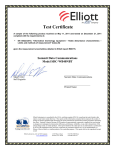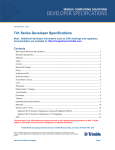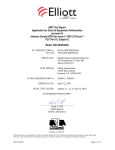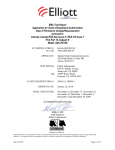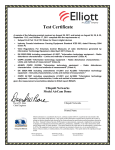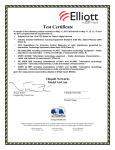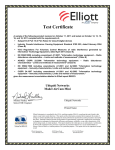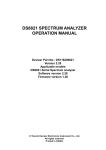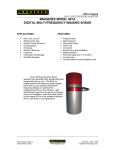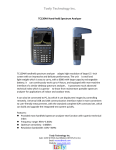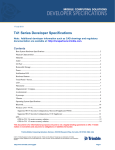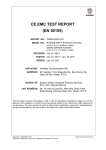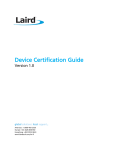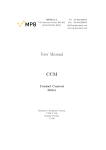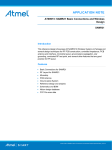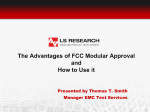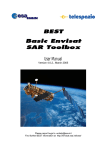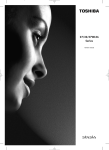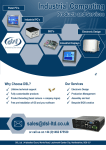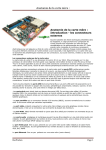Download FHSS Test resport - Summit Data Communications
Transcript
EMC Test Report Application for Grant of Equipment Authorization Industry Canada RSS-Gen Issue 3 / RSS 210 Issue 8 FCC Part 15 Subpart C Model: SDC-SSD40NBT IC CERTIFICATION #: FCC ID: APPLICANT: TEST SITE(S): IC SITE REGISTRATION #: REPORT DATE: FINAL TEST DATES: TOTAL NUMBER OF PAGES: PROGRAM MGR / TECHNICAL REVIEWER: ______________________________ Mark E Hill Staff Engineer 6616A-SDCSSD40NBT TWG-SDCSSD40NBT Summit Data Communications 526 South Main St. Suite 805 Akron, OH 44311 Elliott Laboratories 41039 Boyce Road. Fremont, CA. 94538-2435 2845B-7 March 20, 2012 May 4, 16 and 18 and December 16, 2011 63 QUALITY ASSURANCE DELEGATE / FINAL REPORT PREPARER: ______________________________ David Guidotti Senior Technical Writer Elliott Laboratories is accredited by the A2LA, certificate number 0214.26, to perform the test(s) listed in this report, except where noted otherwise. This report and the information contained herein represent the results of testing test articles identified and selected by the client performed to specifications and/or procedures selected by the client. National Technical Systems (NTS) makes no representations, expressed or implied, that such testing is adequate (or inadequate) to demonstrate efficiency, performance, reliability, or any other characteristic of the articles being tested, or similar products. This report should not be relied upon as an endorsement or certification by NTS of the equipment tested, nor does it represent any statement whatsoever as to its merchantability or fitness of the test article, or similar products, for a particular purpose. This report shall not be reproduced except in full File: R86841 Page 1 Elliott Laboratories -- EMC Department Test Report Report Date: March 20, 2012 REVISION HISTORY Rev# - File: R86841 Date 03-20-2012 Comments Modified By First release Page 2 Elliott Laboratories -- EMC Department Test Report Report Date: March 20, 2012 TABLE OF CONTENTS TITLE PAGE ...............................................................................................................................................................1 REVISION HISTORY ................................................................................................................................................2 TABLE OF CONTENTS ............................................................................................................................................3 SCOPE ..........................................................................................................................................................................4 OBJECTIVE ................................................................................................................................................................5 STATEMENT OF COMPLIANCE ...........................................................................................................................5 DEVIATIONS FROM THE STANDARDS ..............................................................................................................5 TEST RESULTS SUMMARY ...................................................................................................................................6 FREQUENCY HOPPING SPREAD SPECTRUM (2400 – 2483.5 MHZ) ..............................................................6 GENERAL REQUIREMENTS APPLICABLE TO ALL BANDS ..........................................................................7 MEASUREMENT UNCERTAINTIES....................................................................................................................8 EQUIPMENT UNDER TEST (EUT) DETAILS ......................................................................................................9 GENERAL................................................................................................................................................................9 OTHER EUT DETAILS ...........................................................................................................................................9 ANTENNA SYSTEM ..............................................................................................................................................9 ENCLOSURE ...........................................................................................................................................................9 MODIFICATIONS ...................................................................................................................................................9 SUPPORT EQUIPMENT .......................................................................................................................................10 EUT INTERFACE PORTS ....................................................................................................................................10 EUT OPERATION .................................................................................................................................................10 TEST SITE .................................................................................................................................................................11 GENERAL INFORMATION .................................................................................................................................11 CONDUCTED EMISSIONS CONSIDERATIONS ..............................................................................................11 RADIATED EMISSIONS CONSIDERATIONS ..................................................................................................11 MEASUREMENT INSTRUMENTATION ............................................................................................................12 RECEIVER SYSTEM ............................................................................................................................................12 INSTRUMENT CONTROL COMPUTER ............................................................................................................12 LINE IMPEDANCE STABILIZATION NETWORK (LISN) ...............................................................................12 FILTERS/ATTENUATORS ..................................................................................................................................13 ANTENNAS ...........................................................................................................................................................13 ANTENNA MAST AND EQUIPMENT TURNTABLE .......................................................................................13 INSTRUMENT CALIBRATION ...........................................................................................................................13 TEST PROCEDURES ..............................................................................................................................................14 EUT AND CABLE PLACEMENT ........................................................................................................................14 CONDUCTED EMISSIONS ..................................................................................................................................14 RADIATED EMISSIONS ......................................................................................................................................15 CONDUCTED EMISSIONS FROM ANTENNA PORT ......................................................................................17 BANDWIDTH MEASUREMENTS ......................................................................................................................17 SPECIFICATION LIMITS AND SAMPLE CALCULATIONS ...........................................................................18 CONDUCTED EMISSIONS SPECIFICATION LIMITS: FCC 15.207; FCC 15.107(A), RSS GEN ..................18 GENERAL TRANSMITTER RADIATED EMISSIONS SPECIFICATION LIMITS .........................................19 RECEIVER RADIATED SPURIOUS EMISSIONS SPECIFICATION LIMITS .................................................19 OUTPUT POWER LIMITS – FHSS SYSTEMS ...................................................................................................20 TRANSMIT MODE SPURIOUS RADIATED EMISSIONS LIMITS – FHSS AND DTS SYSTEMS.................20 SAMPLE CALCULATIONS - CONDUCTED EMISSIONS ...............................................................................20 SAMPLE CALCULATIONS - RADIATED EMISSIONS ....................................................................................21 SAMPLE CALCULATIONS - FIELD STRENGTH TO EIRP CONVERSION ...................................................22 APPENDIX A TEST EQUIPMENT CALIBRATION DATA ..............................................................................23 APPENDIX B TEST DATA .....................................................................................................................................24 END OF REPORT ....................................................................................................................................................63 File: R86841 Page 3 Elliott Laboratories -- EMC Department Test Report Report Date: March 20, 2012 SCOPE An electromagnetic emissions test has been performed on the Summit Data Communications model SDC-SSD40NBT, pursuant to the following rules: Industry Canada RSS-Gen Issue 3 RSS 210 Issue 8 “Low-power Licence-exempt Radiocommunication Devices (All Frequency Bands): Category I Equipment” FCC Part 15 Subpart C Conducted and radiated emissions data has been collected, reduced, and analyzed within this report in accordance with measurement guidelines set forth in the following reference standards and as outlined in Elliott Laboratories test procedures: ANSI C63.4:2003 FHSS test procedure DA 00-0705A1, March 2000 The intentional radiator above has been tested in a simulated typical installation to demonstrate compliance with the relevant Industry Canada performance and procedural standards. Final system data was gathered in a mode that tended to maximize emissions by varying orientation of EUT, orientation of power and I/O cabling, antenna search height, and antenna polarization. Every practical effort was made to perform an impartial test using appropriate test equipment of known calibration. All pertinent factors have been applied to reach the determination of compliance. File: R86841 Page 4 Elliott Laboratories -- EMC Department Test Report Report Date: March 20, 2012 OBJECTIVE The primary objective of the manufacturer is compliance with the regulations outlined in the previous section. Prior to marketing in the USA, all unlicensed transmitters and transceivers require certification. Receive-only devices operating between 30 MHz and 960 MHz are subject to either certification or a manufacturer’s declaration of conformity, with all other receive-only devices exempt from the technical requirements. Prior to marketing in Canada, Class I transmitters, receivers and transceivers require certification. Class II devices are required to meet the appropriate technical requirements but are exempt from certification requirements. Certification is a procedure where the manufacturer submits test data and technical information to a certification body and receives a certificate or grant of equipment authorization upon successful completion of the certification body’s review of the submitted documents. Once the equipment authorization has been obtained, the label indicating compliance must be attached to all identical units, which are subsequently manufactured. Maintenance of compliance is the responsibility of the manufacturer. Any modification of the product which may result in increased emissions should be checked to ensure compliance has been maintained (i.e., printed circuit board layout changes, different line filter, different power supply, harnessing or I/O cable changes, etc.). STATEMENT OF COMPLIANCE The tested sample of Summit Data Communications model SDC-SSD40NBT complied with the requirements of the following regulations: Industry Canada RSS-Gen Issue 3 RSS 210 Issue 8 “Low-power Licence-exempt Radiocommunication Devices (All Frequency Bands): Category I Equipment” FCC Part 15 Subpart C Maintenance of compliance is the responsibility of the manufacturer. Any modifications to the product should be assessed to determine their potential impact on the compliance status of the device with respect to the standards detailed in this test report. The test results recorded herein are based on a single type test of Summit Data Communications model SDC-SSD40NBT and therefore apply only to the tested sample. The sample was selected and prepared by Ron Seide of Summit Data Communications. DEVIATIONS FROM THE STANDARDS No deviations were made from the published requirements listed in the scope of this report. File: R86841 Page 5 Elliott Laboratories -- EMC Department Test Report Report Date: March 20, 2012 TEST RESULTS SUMMARY FREQUENCY HOPPING SPREAD SPECTRUM (2400 – 2483.5 MHz) FCC Rule Part RSS Rule Part 15.247 (a) (1) RSS 210 A8.1 (1) 15.247 (a) (1) (ii) RSS 210 A8.1 (4) Number of Channels 15.247 (a) (1) (ii) RSS 210 A8.1 (4) Channel Dwell Time (average time of occupancy) 15.247 (a) (1) RSS 210 A8.1 (1) Channel Utilization Description 20dB Bandwidth Channel Separation Measured Value / Comments Basic: 1100kHz EDR: 1400kHz 1000kHz Max: 79 Min: 20 The system uses the Bluetooth algorithm and, therefore, meets all requirements for channel utilization. Limit / Requirement Result Channel spacing > 2/3rds 20dB BW Complies 15 or more <0.4 second within a period of 0.4 x number of channels All channels shall, on average, be used equally Complies Complies Complies Complies Basic: 0.1 dBm (1.0 mW) 15.247 (b) (3) RSS 210 A8.4 (2) Output Power RSS 210 Spurious Emissions – A8.5 30MHz – 25GHz RSS 210 Radiated Spurious 15.247(c) / A8.5 Emissions 15.209 Table 2, 3 30MHz – 25GHz 15.247 RSS 210 Receiver bandwidth (a) (1) A8.1(2) Note 1: EIRP calculated using antenna gain of 2 dBi 15.247(c) File: R86841 EDR: 2.2 dBm (1.7mW) EIRP = 2.6 mW Note 1 All spurious emissions < -20dBc 50.5dBµV/m @ 2483.5MHz (-3.5dB) Refer to operational description 0.125 Watts Complies < -20dBc Complies 15.207 in restricted bands, all others < -20dBc Shall match the channel bandwidth Complies Complies Page 6 Elliott Laboratories -- EMC Department Test Report Report Date: March 20, 2012 GENERAL REQUIREMENTS APPLICABLE TO ALL BANDS FCC Rule Part RSS Rule part Description 15.203 - RF Connector 15.207 RSS GEN Table 2 AC Conducted Emissions 15.109 RSS GEN 7.2.3 Table 1 Receiver spurious emissions RF Exposure Requirements 15.247 (b) (5) 15.407 (f) - File: R86841 RSS 102 RSP 100 RSS GEN 7.1.5 RSP 100 RSS GEN 7.1.5 RSP 100 RSS GEN 4.4.1 Measured Value / Comments EUT uses u.FL connectors 31.9dBµV @ 19.501MHz (-18.1dB) Limit / Requirement Result (margin) Unique or integral antenna required Complies Refer to page 18 Complies 45.5dBµV/m @ 2994.6MHz (-8.5dB) Refer to page 19 Complies Refer to MPE calculations in Exhibit 11, RSS 102 declaration and User Manual statements. Refer to OET 65, FCC Part 1 and RSS 102 Complies Statement required regarding noninterference Statement for products with detachable antenna User Manual User Manual 99% Bandwidth Basic: 973kHz EDR: 1265kHz Information only Complies Complies N/A Page 7 Elliott Laboratories -- EMC Department Test Report Report Date: March 20, 2012 MEASUREMENT UNCERTAINTIES ISO/IEC 17025 requires that an estimate of the measurement uncertainties associated with the emissions test results be included in the report. The measurement uncertainties given below are based on a 95% confidence level and were calculated in accordance with UKAS document LAB 34. Measurement Type RF power, conducted (power meter) RF power, conducted (Spectrum analyzer) Conducted emission of transmitter Conducted emission of receiver Radiated emission (substitution method) Radiated emission (field strength) Conducted Emissions (AC Power) File: R86841 Measurement Unit Frequency Range Expanded Uncertainty dBm 25 to 7000 MHz ± 0.52 dB dBm 25 to 7000 MHz ± 0.7 dB dBm 25 to 26500 MHz ± 0.7 dB dBm 25 to 26500 MHz ± 0.7 dB dBm 25 to 26500 MHz ± 2.5 dB dBμV/m 25 to 1000 MHz 1000 to 40000 MHz ± 3.6 dB ± 6.0 dB dBμV 0.15 to 30 MHz ± 2.4 dB Page 8 Elliott Laboratories -- EMC Department Test Report Report Date: March 20, 2012 EQUIPMENT UNDER TEST (EUT) DETAILS GENERAL The Summit Data Communications model SDC-SSD40NBT is an 802.11abgn 1x1 with Bluetooth 2.1 module. The sample was received on October 19, 2010 and tested on May 4, 16 and 18 and December 16, 2011. The EUT consisted of the following component(s): Company Summit Model SDCSSD40NBT Description 802.11abgn 1x with BT Serial Number Prototype FCC ID TWGSDCSSD40NBT OTHER EUT DETAILS The EUT supports single transmit chain operation. The SSD40NBT Module was tested on a MSD40NBT board. ANTENNA SYSTEM Dipole Antenna #1 - 2.4 and 5GHz bands - Larsen, R380.500.314, 1.6dBi (2.4GHz), 5dBi (5GHz) Dipole Antenna #2 - 2.4 GHz only - Cisco Air-Ant 4941 2dBi(2.4GHz) In the 2.4GHz range, the Cisco antenna was tested as they represented the highest gain antennas of each available type. The antenna connects to the EUT via a non-standard u.FL antenna connector, thereby meeting the requirements of FCC 15.203. ENCLOSURE The EUT has no enclosure. It is designed to be installed within the enclosure of a host computer. MODIFICATIONS No modifications were made to the EUT during the time the product was at Elliott. File: R86841 Page 9 Elliott Laboratories -- EMC Department Test Report Report Date: March 20, 2012 SUPPORT EQUIPMENT The following equipment was used as support equipment for testing: Company Model Delta Electronics EADP-10BB HP iPaQ Description Serial Number AC/DC Adapter 59A401Z9UP42K PDA 2CK702010G Laptop Computer Lenovo Inspiron 1545 953R2K1 (Note 1) Note 1 – Used to configure the BT radio and then disconnected FCC ID N/A N/A DoC EUT INTERFACE PORTS The I/O cabling configuration during testing was as follows: Port AC/DC Adapter AC/DC Adapter Description Cable(s) Shielded or Unshielded Length(m) iPaq 2wire Unshielded 1.5m AC Mains - - - Connected To EUT OPERATION During testing, the EUT was configured to transmit on a single channel continuously at the maximum power. File: R86841 Page 10 Elliott Laboratories -- EMC Department Test Report Report Date: March 20, 2012 TEST SITE GENERAL INFORMATION Final test measurements were taken at the test sites listed below. Pursuant to section 2.948 of the FCC’s Rules and section 3.3 of RSP-100, construction, calibration, and equipment data has been filed with the Commission and with industry Canada. Site Chamber 7 Registration Numbers FCC Canada A2LA accreditation 2845B-7 Location 41039 Boyce Road Fremont, CA 94538-2435 ANSI C63.4:2003 recommends that ambient noise at the test site be at least 6 dB below the allowable limits. Ambient levels are below this requirement. The test site(s) contain separate areas for radiated and conducted emissions testing. Considerable engineering effort has been expended to ensure that the facilities conform to all pertinent requirements of ANSI C63.4:2003. CONDUCTED EMISSIONS CONSIDERATIONS Conducted emissions testing is performed in conformance with ANSI C63.4:2003. Measurements are made with the EUT connected to the public power network through a nominal, standardized RF impedance, which is provided by a line impedance stabilization network, known as a LISN. A LISN is inserted in series with each current-carrying conductor in the EUT power cord. RADIATED EMISSIONS CONSIDERATIONS The FCC has determined that radiation measurements made in a shielded enclosure are not suitable for determining levels of radiated emissions. Radiated measurements are performed in an open field environment or in a semi-anechoic chamber. The test sites are maintained free of conductive objects within the CISPR defined elliptical area incorporated in ANSI C63.4:2003 guidelines and meet the Normalized Site Attenuation (NSA) requirements of ANSI C63.4:2003. File: R86841 Page 11 Elliott Laboratories -- EMC Department Test Report Report Date: March 20, 2012 MEASUREMENT INSTRUMENTATION RECEIVER SYSTEM An EMI receiver as specified in CISPR 16-1-1 is used for emissions measurements. The receivers used can measure over the frequency range of 9 kHz up to 2000 MHz. These receivers allow both ease of measurement and high accuracy to be achieved. The receivers have Peak, Average, and CISPR (Quasi-peak) detectors built into their design so no external adapters are necessary. The receiver automatically sets the required bandwidth for the CISPR detector used during measurements. If the repetition frequency of the signal being measured is below 20Hz, peak measurements are made in lieu of Quasi-Peak measurements. For measurements above the frequency range of the receivers, a spectrum analyzer is utilized because it provides visibility of the entire spectrum along with the precision and versatility required to support engineering analysis. Average measurements above 1000MHz are performed on the spectrum analyzer using the linear-average method with a resolution bandwidth of 1 MHz and a video bandwidth of 10 Hz, unless the signal is pulsed in which case the average (or video) bandwidth of the measuring instrument is reduced to onset of pulse desensitization and then increased. INSTRUMENT CONTROL COMPUTER The receivers utilize either a Rohde & Schwarz EZM Spectrum Monitor/Controller or contain an internal Spectrum Monitor/Controller to view and convert the receiver measurements to the field strength at an antenna or voltage developed at the LISN measurement port, which is then compared directly with the appropriate specification limit. This provides faster, more accurate readings by performing the conversions described under Sample Calculations within the Test Procedures section of this report. Results are printed in a graphic and/or tabular format, as appropriate. A personal computer is used to record all measurements made with the receivers. The Spectrum Monitor provides a visual display of the signal being measured. In addition, the controller or a personal computer run automated data collection programs which control the receivers. This provides added accuracy since all site correction factors, such as cable loss and antenna factors are added automatically. LINE IMPEDANCE STABILIZATION NETWORK (LISN) Line conducted measurements utilize a fifty microhenry Line Impedance Stabilization Network as the monitoring point. The LISN used also contains a 250 uH CISPR adapter. This network provides for calibrated radio frequency noise measurements by the design of the internal low pass and high pass filters on the EUT and measurement ports, respectively. File: R86841 Page 12 Elliott Laboratories -- EMC Department Test Report Report Date: March 20, 2012 FILTERS/ATTENUATORS External filters and precision attenuators are often connected between the receiving antenna or LISN and the receiver. This eliminates saturation effects and non-linear operation due to high amplitude transient events. ANTENNAS A loop antenna is used below 30 MHz. For the measurement range 30 MHz to 1000 MHz either a combination of a biconical antenna and a log periodic or a bi-log antenna is used. Above 1000 MHz, horn antennas are used. The antenna calibration factors to convert the received voltage to an electric field strength are included with appropriate cable loss and amplifier gain factors to determine an overall site factor, which is then programmed into the test receivers or incorporated into the test software. ANTENNA MAST AND EQUIPMENT TURNTABLE The antennas used to measure the radiated electric field strength are mounted on a nonconductive antenna mast equipped with a motor-drive to vary the antenna height. Measurements below 30 MHz are made with the loop antenna at a fixed height of 1m above the ground plane. ANSI C63.4:2003 specifies that the test height above ground for table mounted devices shall be 80 centimeters. Floor mounted equipment shall be placed on the ground plane if the device is normally used on a conductive floor or separated from the ground plane by insulating material from 3 to 12 mm if the device is normally used on a non-conductive floor. During radiated measurements, the EUT is positioned on a motorized turntable in conformance with this requirement. INSTRUMENT CALIBRATION All test equipment is regularly checked to ensure that performance is maintained in accordance with the manufacturer's specifications. All antennas are calibrated at regular intervals with respect to tuned half-wave dipoles. An exhibit of this report contains the list of test equipment used and calibration information. File: R86841 Page 13 Elliott Laboratories -- EMC Department Test Report Report Date: March 20, 2012 TEST PROCEDURES EUT AND CABLE PLACEMENT The regulations require that interconnecting cables be connected to the available ports of the unit and that the placement of the unit and the attached cables simulate the worst case orientation that can be expected from a typical installation, so far as practicable. To this end, the position of the unit and associated cabling is varied within the guidelines of ANSI C63.4:2003, and the worst-case orientation is used for final measurements. CONDUCTED EMISSIONS Conducted emissions are measured at the plug end of the power cord supplied with the EUT. Excess power cord length is wrapped in a bundle between 30 and 40 centimeters in length near the center of the cord. Preliminary measurements are made to determine the highest amplitude emission relative to the specification limit for all the modes of operation. Placement of system components and varying of cable positions are performed in each mode. A final peak mode scan is then performed in the position and mode for which the highest emission was noted on all current carrying conductors of the power cord. LISN EUT LISN AE 0.4m 0.8m Figure 1 Typical Conducted Emissions Test Configuration File: R86841 Page 14 Elliott Laboratories -- EMC Department Test Report Report Date: March 20, 2012 RADIATED EMISSIONS A preliminary scan of the radiated emissions is performed in which all significant EUT frequencies are identified with the system in a nominal configuration. At least two scans are performed, one scan for each antenna polarization (horizontal and vertical; loop parallel and perpendicular to the EUT). During the preliminary scans, the EUT is rotated through 360˚, the antenna height is varied (for measurements above 30 MHz) and cable positions are varied to determine the highest emission relative to the limit. Preliminary scans may be performed in a fully anechoic chamber for the purposes of identifying the frequencies of the highest emissions from the EUT. A speaker is provided in the receiver to aid in discriminating between EUT and ambient emissions. Other methods used during the preliminary scan for EUT emissions involve scanning with near field magnetic loops, monitoring I/O cables with RF current clamps, and cycling power to the EUT. Final maximization is a phase in which the highest amplitude emissions identified in the spectral search are viewed while the EUT azimuth angle is varied from 0 to 360 degrees relative to the receiving antenna. The azimuth, which results in the highest emission is then maintained while varying the antenna height from one to four meters (for measurements above 30 MHz, measurements below 30 MHz are made with the loop antenna at a fixed height of 1m). The result is the identification of the highest amplitude for each of the highest peaks. Each recorded level is corrected in the receiver using appropriate factors for cables, connectors, antennas, and preamplifier gain. When testing above 18 GHz, the receive antenna is located at 1meter from the EUT and the antenna height is restricted to a maximum of 2.5 meters. REAR VIEW 0.4m AC Outlets (flush-mounted) 0.8m SIDE VIEW Typical Test Configuration for Radiated Field Strength Measurements File: R86841 Page 15 Elliott Laboratories -- EMC Department Test Report Report Date: March 20, 2012 EUT d Antenna The anechoic materials on the walls and ceiling ensure compliance with the normalized site attenuation requirements of CISPR 16 / CISPR 22 / ANSI C63.4 for an alternate test site at the measurement distances used. Floor-standing equipment is placed on the floor with insulating supports between the unit and the ground plane. EUT d Antenna height range 1 to 4 m 0.8m Test Configuration for Radiated Field Strength Measurements Semi-Anechoic Chamber, Plan and Side Views File: R86841 Page 16 Elliott Laboratories -- EMC Department Test Report Report Date: March 20, 2012 CONDUCTED EMISSIONS FROM ANTENNA PORT Direct measurements of power, bandwidth and power spectral density are performed, where possible, with the antenna port of the EUT connected to either the power meter or spectrum analyzer via a suitable attenuator and/or filter. These are used to ensure that the front end of the measurement instrument is not overloaded by the fundamental transmission. EUT Attenuator (optional) Spectrum Analyzer (or Power Meter) Test Configuration for Antenna Port Measurements Measurement bandwidths (video and resolution) are set in accordance with the relevant standards and Elliott’s test procedures for the type of radio being tested. When power measurements are made using a resolution bandwidth less than the signal bandwidth the power is calculated by summing the power across the signal bandwidth using either the analyzer channel power function or by capturing the trace data and calculating the power using software. In both cases the summed power is corrected to account for the equivalent noise bandwidth (ENBW) of the resolution bandwidth used. If power averaging is used (typically for certain digital modulation techniques), the EUT is configured to transmit continuously. Power averaging is performed using either the built-in function of the analyzer or, if the analyzer does not feature power averaging, using external software. In both cases the average power is calculated over a number of sweeps (typically 100). When the EUT cannot be configured to continuously transmit then either the analyzer is configured to perform a gated sweep to ensure that the power is averaged over periods that the device is transmitting or power averaging is disabled and a max-hold feature is used. If a power meter is used to make output power measurements the sensor head type (peak or average) is stated in the test data table. BANDWIDTH MEASUREMENTS The 6dB, 20dB and/or 26dB signal bandwidth is measured in using the bandwidths recommended by ANSI C63.4. When required, the 99% bandwidth is measured using the methods detailed in RSS GEN. File: R86841 Page 17 Elliott Laboratories -- EMC Department Test Report Report Date: March 20, 2012 SPECIFICATION LIMITS AND SAMPLE CALCULATIONS The limits for conducted emissions are given in units of microvolts, and the limits for radiated emissions are given in units of microvolts per meter at a specified test distance. Data is measured in the logarithmic form of decibels relative to one microvolt, or dB microvolts (dBuV). For radiated emissions, the measured data is converted to the field strength at the antenna in dB microvolts per meter (dBuV/m). The results are then converted to the linear forms of uV and uV/m for comparison to published specifications. For reference, converting the specification limits from linear to decibel form is accomplished by taking the base ten logarithm, then multiplying by 20. These limits in both linear and logarithmic form are as follows: CONDUCTED EMISSIONS SPECIFICATION LIMITS: FCC 15.207; FCC 15.107(a), RSS GEN The table below shows the limits for the emissions on the AC power line from an intentional radiator and a receiver. Frequency (MHz) 0.150 to 0.500 0.500 to 5.000 5.000 to 30.000 File: R86841 Average Limit (dBuV) Quasi Peak Limit (dBuV) Linear decrease on logarithmic frequency axis between 56.0 and 46.0 46.0 50.0 Linear decrease on logarithmic frequency axis between 66.0 and 56.0 56.0 60.0 Page 18 Elliott Laboratories -- EMC Department Test Report Report Date: March 20, 2012 GENERAL TRANSMITTER RADIATED EMISSIONS SPECIFICATION LIMITS The table below shows the limits for the spurious emissions from transmitters that fall in restricted bands 1 (with the exception of transmitters operating under FCC Part 15 Subpart D and RSS 210 Annex 9), the limits for all emissions from a low power device operating under the general rules of RSS 310 (tables 3 and 4), RSS 210 (table 2) and FCC Part 15 Subpart C section 15.209. Frequency Range (MHz) 0.009-0.490 Limit (uV/m) Limit (dBuV/m @ 3m) 2400/FKHz @ 300m 67.6-20*log10(FKHz) @ 300m 0.490-1.705 24000/FKHz @ 30m 87.6-20*log10(FKHz) @ 30m 1.705 to 30 30 @ 30m 29.5 @ 30m 30 to 88 100 @ 3m 40 @ 3m 88 to 216 150 @ 3m 43.5 @ 3m 216 to 960 200 @ 3m 46.0 @ 3m Above 960 500 @ 3m 54.0 @ 3m RECEIVER RADIATED SPURIOUS EMISSIONS SPECIFICATION LIMITS The table below shows the limits for the spurious emissions from receivers as detailed in FCC Part 15.109, RSS 210 Table 2, RSS GEN Table 1 and RSS 310 Table 3. Note that receivers operating outside of the frequency range 30 MHz – 960 MHz are exempt from the requirements of 15.109. Frequency Range (MHz) 30 to 88 1 Limit (uV/m @ 3m) Limit (dBuV/m @ 3m) 100 40 88 to 216 150 43.5 216 to 960 200 46.0 Above 960 500 54.0 The restricted bands are detailed in FCC 15.203, RSS 210 Table 1 and RSS 310 Table 2 File: R86841 Page 19 Elliott Laboratories -- EMC Department Test Report Report Date: March 20, 2012 OUTPUT POWER LIMITS – FHSS SYSTEMS The table below shows the limits for output power based on the number of channels available for the hopping system. Operating Frequency (MHz) 902 – 928 902 – 928 2400 – 2483.5 2400 – 2483.5 5725 – 5850 Number of Channels Output Power ≥ 50 25 to 49 ≥ 75 < 75 75 1 Watt (30 dBm) 0.25 Watts (24 dBm) 1 Watt (30 dBm) 0.125 Watts (21 dBm) 1 Watt (30 dBm) The maximum permitted output power is reduced by 1dB for every dB the antenna gain exceeds 6dBi. Fixed point-to-point applications using the 5725 – 5850 MHz band are not subject to this restriction. TRANSMIT MODE SPURIOUS RADIATED EMISSIONS LIMITS – FHSS and DTS SYSTEMS The limits for unwanted (spurious) emissions from the transmitter falling in the restricted bands are those specified in the general limits sections of FCC Part 15 and RSS 210. All other unwanted (spurious) emissions shall be at least 20dB below the level of the highest in-band signal level (30dB if the power is measured using the sample detector/power averaging method). SAMPLE CALCULATIONS - CONDUCTED EMISSIONS Receiver readings are compared directly to the conducted emissions specification limit (decibel form) as follows: Rr - S = M where: Rr = Receiver Reading in dBuV S = Specification Limit in dBuV M = Margin to Specification in +/- dB File: R86841 Page 20 Elliott Laboratories -- EMC Department Test Report Report Date: March 20, 2012 SAMPLE CALCULATIONS - RADIATED EMISSIONS Receiver readings are compared directly to the specification limit (decibel form). The receiver internally corrects for cable loss, preamplifier gain, and antenna factor. The calculations are in the reverse direction of the actual signal flow, thus cable loss is added and the amplifier gain is subtracted. The Antenna Factor converts the voltage at the antenna coaxial connector to the field strength at the antenna elements. A distance factor, when used for electric field measurements above 30MHz, is calculated by using the following formula: Fd = 20*LOG10 (Dm/Ds) where: Fd = Distance Factor in dB Dm = Measurement Distance in meters Ds = Specification Distance in meters For electric field measurements below 30MHz the extrapolation factor is either determined by making measurements at multiple distances or a theoretical value is calculated using the formula: Fd = 40*LOG10 (Dm/Ds) Measurement Distance is the distance at which the measurements were taken and Specification Distance is the distance at which the specification limits are based. The antenna factor converts the voltage at the antenna coaxial connector to the field strength at the antenna elements. The margin of a given emission peak relative to the limit is calculated as follows: Rc = Rr + Fd and M = Rc - Ls where: Rr = Receiver Reading in dBuV/m Fd = Distance Factor in dB Rc = Corrected Reading in dBuV/m Ls = Specification Limit in dBuV/m M = Margin in dB Relative to Spec File: R86841 Page 21 Elliott Laboratories -- EMC Department Test Report Report Date: March 20, 2012 SAMPLE CALCULATIONS - FIELD STRENGTH TO EIRP CONVERSION Where the radiated electric field strength is expressed in terms of the equivalent isotropic radiated power (eirp), or where a field strength measurement of output power is made in lieu of a direct measurement, the following formula is used to convert between eirp and field strength at a distance of d (meters) from the equipment under test: E = 1000000 √ 30 P microvolts per meter d where P is the eirp (Watts) For a measurement at 3m the conversion from a logarithmic value for field strength (dBuV/m) to an eirp power (dBm) is -95.3dB. File: R86841 Page 22 Elliott Laboratories -- EMC Department Test Report Report Date: March 20, 2012 Appendix A Test Equipment Calibration Data Radiated Emissions, 1,000 - 18,000 MHz, 16-May-11 Description Manufacturer Hewlett Packard Microwave Preamplifier, 126.5GHz EMCO Antenna, Horn, 1-18GHz Hewlett Packard SpecAn 30 Hz -40 GHz, SV (SA40) Red Micro-Tronics Band Reject Filter, 2400-2500 MHz Model 8449B Asset # 263 Cal Due 12/8/2011 3115 8564E (84125C) 868 1148 6/8/2012 7/12/2011 BRM50702-02 2238 10/1/2011 Asset # 1071 1393 Cal Due 6/1/2011 6/14/2011 1536 9/13/2011 Asset # 785 Cal Due 5/18/2012 1386 9/21/2012 1393 6/14/2011 1682 3/23/2012 Asset # 1292 1756 Cal Due 3/1/2012 4/6/2012 Radio Antenna Port (Power and Spurious Emissions), 18-May-11 Description Model Manufacturer Rohde & Schwarz Power Meter, Dual Channel NRVD Hewlett Packard SpecAn 9 kHz - 40 GHz, FT 8564E (84125C) (SA40) Blue Rohde & Schwarz Power Sensor 100 uW - 2 Watts NRV-Z32 (w/ 20 dB pad, SN BJ5155) Radiated Spurious Emissions, 1000 - 25,000 MHz, 18-May-11 Description Model Manufacturer Hewlett Packard Microwave Preamplifier, 18449B 26.5GHz EMCO Antenna, Horn, 1-18 GHz 3115 (SA40-Blu) Hewlett Packard SpecAn 9 kHz - 40 GHz, FT 8564E (84125C) (SA40) Blue Micro-Tronics Band Reject Filter, 5725-5875 BRC50705-02 MHz Conducted Emissions - AC Power Ports, 16-Dec-11 Description Manufacturer EMCO LISN, 10 kHz-100 MHz, 25A Rohde & Schwarz EMI Test Receiver, 20 Hz-7 GHz File: R86841 Model 3825/2 ESIB7 Page 23 Elliott Laboratories -- EMC Department Test Report Report Date: March 20, 2012 Appendix B Test Data T83197 Pages 25 – 53 T83198 Pages 54 - 62 File: R86841 Page 24 EMC Test Data Client: Summit Data Communications Model: SDC-MSD40NBT (1x1 802.11abg + BT 2.1) Contact: Ron Seide Emissions Standard(s): FCC 15.247/RSS-210 Immunity Standard(s): EN 301 489-1 V1.8.1 Job Number: J78403 T-Log Number: T83197 Account Manager: Christine Krebill Class: Environment: - EMC Test Data For The Summit Data Communications Model SDC-MSD40NBT ((1x1 802.11abg g + BT 2.1)) Date of Last Test: R86841 Cover Page 25 EMC Test Data Client: Summit Data Communications Job Number: J78403 T-Log Number: T83197 Account Manager: Christine Krebill Model: SDC-MSD40NBT (1x1 802.11abg + BT 2.1) Contact: Ron Seide Standard: FCC 15.247/RSS-210 Class: N/A RSS 210 and FCC 15.247 (DTS) Radiated Spurious Emissions (Bluetooth) Summary of Results - Device Operating in the 2400-2483.5 MHz Band Bluetooth uses a frequency hopping algorithm that means that the device, during normal operation, is only on a specific channel for a short period of time. The average correction factor is calculated as follows: A maximum length packet has a duration of 5 time slots. The hopping rate is 1600 hops/second so the maximum dwell time is 5/1600 seconds, or 3.125ms. With a minimum of 20 hopping channels a channel will not be used more than 4 times in any 100ms period. The maximum dwell time in a 100m period is 4 x 3.125ms = 12.5ms. The average correction factor is, therefore, 20log(12.5/100) =-18dB As this is a hopping radio the correction factor can be applied to the average value of the signal provided the average value was measured with the device continuously transmitting. DA 00-0705 permits the use of the average correction on the measured average value for frequency hopping radios. Run # Mode Channel Antenna Power Setting 2402MHz Cisco Default Run # 1 Basic (1 Mb/s) Chain A 2480MHz Cisco Default 2402MHz Cisco Default 2480MHz Cisco Default Run # 2 EDR (3 Mb/s) Chain A Test Performed Restricted Band Edge at 2390 MHz Restricted Band Edge at 2483.5 MHz Restricted Band Edge at 2390 MHz Restricted Band Edge at 2483.5 MHz Limit 15.209 15.209 15.209 15.209 Result / Margin 47.3dBµV/m @ 2353.3MHz (-6.7dB) 49.1dBµV/m @ 2483.5MHz (-4.9dB) 47.2dBµV/m @ 2379.3MHz (-6.8dB) 50.5dBµV/m @ 2483.5MHz (-3.5dB) Test Specific Details Objective: The objective of this test session is to perform final qualification testing of the EUT with respect to the specification listed above. General Test Configuration The EUT and all local support equipment were located on the turntable for radiated spurious emissions testing. For radiated emissions testing the measurement antenna was located 3 meters from the EUT. Ambient Conditions: Temperature: Rel. Humidity: 20-25 °C 40-50 % Modifications Made During Testing No modifications were made to the EUT during testing Deviations From The Standard No deviations were made from the requirements of the standard. R86841 BT 2.4GHz BE - Cisco Page 26 EMC Test Data Client: Summit Data Communications Job Number: J78403 T-Log Number: T83197 Account Manager: Christine Krebill Model: SDC-MSD40NBT (1x1 802.11abg + BT 2.1) Contact: Ron Seide Standard: FCC 15.247/RSS-210 Class: N/A Run # 1, Band Edge Field Strength - Basic (1 Mb/s), Chain A Date of Test: 5/16/2011 Test Engineer: Mark Hill Run # 1a, EUT on Channel 2402MHz - Basic (1 Mb/s), Chain A 2390 MHz Band Edge Signal Field Strength 15.209 / 15.247 Frequency Level Pol v/h Limit Margin MHz dBμV/m 2353.270 47.3 H 54.0 -6.7 2357.400 47.1 V 54.0 -6.9 2387.730 59.2 V 74.0 -14.8 2357.800 58.4 H 74.0 -15.6 R86841 Test Location: FT#7 Config Change: none Detector Pk/QP/Avg AVG AVG PK PK Azimuth degrees 248 237 237 248 BT 2.4GHz BE - Cisco Height meters 1.0 1.0 1.0 1.0 Comments RB 1 MHz;VB 10 Hz;Pk RB 1 MHz;VB 10 Hz;Pk RB 1 MHz;VB 3 MHz;Pk RB 1 MHz;VB 3 MHz;Pk Page 27 EMC Test Data Client: Summit Data Communications Job Number: J78403 T-Log Number: T83197 Account Manager: Christine Krebill Model: SDC-MSD40NBT (1x1 802.11abg + BT 2.1) Contact: Ron Seide Standard: FCC 15.247/RSS-210 Class: N/A Run # 1b, EUT on Channel 2480MHz - Basic (1 Mb/s), Chain A 2483.5 MHz Band Edge Signal Radiated Field Strength 15.209 / 15.247 Frequency Level Pol Detector v/h Limit Margin g Pk/QP/Avg Q g MHz dBμV/m 2483.500 49.1 V 54.0 -4.9 AVG 2491.280 59.8 V 74.0 -14.2 PK R86841 Azimuth degrees g 234 234 BT 2.4GHz BE - Cisco Height Comments meters 1.0 RB 1 MHz;VB 10 Hz;Pk 1.0 RB 1 MHz;VB 3 MHz;Pk Page 28 EMC Test Data Client: Summit Data Communications Job Number: J78403 T-Log Number: T83197 Account Manager: Christine Krebill Model: SDC-MSD40NBT (1x1 802.11abg + BT 2.1) Contact: Ron Seide Standard: FCC 15.247/RSS-210 Class: N/A Run # 2, Band Edge Field Strength - EDR (3 Mb/s), Chain A Date of Test: 5/16/2011 Test Engineer: Mark Hill Run # 2a, EUT on Channel 2402MHz - EDR (3 Mb/s), Chain A 2390 MHz Band Edge Signal Field Strength 15.209 / 15.247 Frequency Level Pol v/h Limit Margin MHz dBμV/m 2379.270 47.2 V 54.0 -6.8 2360.130 58.6 V 74.0 -15.4 Test Location: FT#7 Config Change: none Detector Pk/QP/Avg AVG PK Azimuth degrees 237 237 Height meters 1.0 1.0 Comments RB 1 MHz;VB 10 Hz;Pk RB 1 MHz;VB 3 MHz;Pk Vertical R86841 BT 2.4GHz BE - Cisco Page 29 EMC Test Data Client: Summit Data Communications Job Number: J78403 T-Log Number: T83197 Account Manager: Christine Krebill Model: SDC-MSD40NBT (1x1 802.11abg + BT 2.1) Contact: Ron Seide Standard: FCC 15.247/RSS-210 Class: N/A Run # 2b, EUT on Channel 2480MHz - EDR (3 Mb/s), Chain A 2483.5 MHz Band Edge Signal Radiated Field Strength 15.209 / 15.247 Frequency Level Pol v/h Limit Margin MHz dBμV/m 2483.500 50.5 V 54.0 -3.5 2488.090 59.9 V 74.0 -14.1 R86841 Detector Pk/QP/Avg AVG PK Azimuth degrees 233 233 BT 2.4GHz BE - Cisco Height meters 1.0 1.0 Comments RB 1 MHz;VB 10 Hz;Pk RB 1 MHz;VB 3 MHz;Pk Page 30 EMC Test Data Client: Summit Data Communications Job Number: J78403 T-Log Number: T83197 Account Manager: Christine Krebill Model: SDC-MSD40NBT (1x1 802.11abg + BT 2.1) Contact: Ron Seide Standard: FCC 15.247/RSS-210 Class: N/A RSS 210 and FCC 15.247 (DTS) Radiated Spurious Emissions (Bluetooth) Summary of Results - Device Operating in the 2400-2483.5 MHz Band For Bluetooth: Tx is chain B, Rx is chain B Bluetooth uses a frequency hopping algorithm that means that the device, during normal operation, is only on a specific channel for a short period of time. The average correction factor is calculated as follows: A maximum length packet has a duration of 5 time slots. The hopping rate is 1600 hops/second so the maximum dwell time is 5/1600 seconds, or 3.125ms. With a minimum of 20 hopping channels a channel will not be used more than 4 times in any 100ms period. The maximum dwell time in a 100m period is 4 x 3.125ms = 12.5ms. The average correction factor is, therefore, 20log(12.5/100) =-18dB As this is a hopping radio the correction factor can be applied to the average value of the signal provided the average value was measured with the device continuously transmitting. DA 00-0705 permits the use of the average correction on the measured average value for frequency hopping radios. Run # R #1 Run Run # 2 3 Channel Antenna Power Setting 2402MHz Cisco Default 2440MH 2440MHz Ci Cisco D f lt Default 2480MHz Cisco Default 2402MHz Cisco Default 2440MHz Cisco Default 2480MHz Cisco Default 2440 Cisco - Mode Basic (1 Mb/ ) Mb/s) Chain A EDR (3 Mb/s) Chain A Bluetooth Receive Test Performed Radiated Emissions,, 1 - 26 GHz Radiated Emissions, 1 - 26 GHz Radiated Emissions, 1 - 7.5 GHz Limit Result / Margin 46.7dBµV/m @ 2994.6MHz (-7.3dB) 46.9 dBµV/m µ @ 3223.5 FCC 15 15.209 209 / 15.247 15 247 MHz (-7.1 dB) 47.5dBµV/m @ 1653.4MHz (-6.5dB) 46.2dBµV/m @ 2994.5MHz (-7.8dB) 47.0dBµV/m @ FCC 15.209 / 15.247 2994.4MHz (-7.0dB) 46.6dBµV/m @ 1653.2MHz (-7.4dB) 45.5dBµV/m @ RSS 210 2994.6MHz (-8.5dB) Test Specific Details Objective: The objective of this test session is to perform final qualification testing of the EUT with respect to the specification listed above. General Test Configuration The EUT and all local support equipment were located on the turntable for radiated spurious emissions testing. For radiated emissions testing the measurement antenna was located 3 meters from the EUT. Ambient Conditions: R86841 Temperature: Rel. Humidity: 20-25 °C 40-50 % BT 2.4GHz RE - Cisco Page 31 EMC Test Data Client: Summit Data Communications Job Number: J78403 T-Log Number: T83197 Account Manager: Christine Krebill Model: SDC-MSD40NBT (1x1 802.11abg + BT 2.1) Contact: Ron Seide Standard: FCC 15.247/RSS-210 Class: N/A Modifications Made During Testing No modifications were made to the EUT during testing Deviations From The Standard No deviations were made from the requirements of the standard. Run #1, Radiated Spurious Emissions, 1-26GHz, Basic (1 Mb/s), Chain A Date of Test: 5/16/2011& 5/18/11 Test Location: FT #7 Test Engineer: Mark Hill / John Caizzi Config Change: Run #1a, EUT on Channel 2402MHz - Basic (1 Mb/s), Chain A Frequency MHz 2994.640 1601.330 1601.400 2994.640 2994 670 2994.670 Note 1: Note 2: R86841 Level dBμV/m 46.7 46.2 47.6 45.9 50 4 50.4 Pol v/h V H H V V 15.209/15.247 Limit Margin 54.0 -7.3 54.0 -7.8 74.0 -26.4 54.0 -8.1 74 0 74.0 -23 23.66 Detector Pk/QP/Avg Pk AVG PK AVG PK Azimuth degrees 124 212 212 124 124 Height Comments meters 1.00 RB 100 kHz;VB 100 kHz, Note 2 1.27 1.27 1.00 Note 2 1 00 Note 2 1.00 For emissions in restricted bands, the limit of 15.209 was used. For all other emissions, the limit is -30dBc for peak measurements in a measurement bandwidth of 100kHz. Emission not in restricted band but restricted band limit used. BT 2.4GHz RE - Cisco Page 32 EMC Test Data Client: Summit Data Communications Job Number: J78403 T-Log Number: T83197 Account Manager: Christine Krebill Model: SDC-MSD40NBT (1x1 802.11abg + BT 2.1) Contact: Ron Seide Standard: FCC 15.247/RSS-210 Class: N/A Run #1b: , EUT on Channel 2440MHz - Basic (1 Mb/s), Chain A Spurious Radiated Emissions: Frequency Level Pol v/h MHz dBμV/m 3223.470 46.9 H 2994.390 45.4 V 1626.500 42.3 H 1626.460 45.1 H Note 1: Note 2: Note 4: R86841 15.209/15.247 Limit Margin 54.0 -7.1 54.0 -8.6 54.0 -11.7 74.0 -28.9 Detector Pk/QP/Avg Peak Peak AVG PK Azimuth degrees 233 128 87 87 Height meters 1.0 1.0 1.0 1.0 Comments Note 4 Note 4 RB 1 MHz;VB 10 Hz;Pk RB 1 MHz;VB 3 MHz;Pk For emissions in restricted bands, the limit of 15.209 was used. For all other emissions, the limit is -30dBc for peak measurements in a measurement bandwidth of 100kHz. Scans made between 18 - 26GHz with the measurement antenna moved around the card and its antennas 20-50cm from the device indicated there were no signifcant emissions in this frequency range Emission not in restricted band but restricted band limit used. BT 2.4GHz RE - Cisco Page 33 EMC Test Data Client: Summit Data Communications Job Number: J78403 T-Log Number: T83197 Account Manager: Christine Krebill Model: SDC-MSD40NBT (1x1 802.11abg + BT 2.1) Contact: Ron Seide Standard: FCC 15.247/RSS-210 Class: N/A Run #1c: , EUT on Channel 2480MHz - Basic (1 Mb/s), Chain A Spurious Radiated Emissions: Frequency Level Pol v/h MHz dBμV/m 1653.350 47.5 V 1653.390 47.0 V 1653.330 49.2 V 2994.710 42.4 V 2994.730 49.7 V 2994.640 43.8 V Note 1: Note 2: R86841 15.209/15.247 Limit Margin 54.0 -6.5 54.0 -7.0 74.0 -24.8 54.0 -11.6 74.0 -24.3 54.0 -10.2 Detector Pk/QP/Avg PK AVG PK AVG PK PK Azimuth degrees 191 191 191 348 348 348 Height meters 1.0 1.0 1.0 1.0 1.0 1.0 Comments Note 2 RB 1 MHz;VB 10 Hz;Pk, note 2 RB 1 MHz;VB 3 MHz;Pk, note 2 RB 1 MHz;VB 10 Hz;Pk, note 2 RB 1 MHz;VB 3 MHz;Pk, note 2 Note 2 For emissions in restricted bands, the limit of 15.209 was used. For all other emissions, the limit is -30dBc for peak measurements in a measurement bandwidth of 100kHz. Emission not in restricted band but restricted band limit used. BT 2.4GHz RE - Cisco Page 34 EMC Test Data Client: Summit Data Communications Job Number: J78403 T-Log Number: T83197 Account Manager: Christine Krebill Model: SDC-MSD40NBT (1x1 802.11abg + BT 2.1) Contact: Ron Seide Standard: FCC 15.247/RSS-210 Class: N/A Run # 2, Radiated Spurious Emissions, 1-26GHz, EDR (3 Mb/s), Chain A Test Location: FT Chamber #7 Date of Test: 5/18/2011 Test Engineer: Rafael Varelas Config Change: None Run # 2a, EUT on Channel 2402MHz - EDR (3 Mb/s), Chain A Spurious Radiated Emissions: Frequency Level Pol v/h MHz dBμV/m 2994.480 46.2 V 1601.330 44.5 V 1601.280 47.0 V 3231.360 45.9 H 3456.290 44.6 V Note 1: Note 3: R86841 15.209/15.247 Limit Margin 54.0 -7.8 54.0 -9.5 74.0 -27.0 54.0 -8.1 54.0 -9.4 Detector Pk/QP/Avg Peak AVG PK Peak Peak Azimuth degrees 119 165 165 212 157 Height meters 1.0 1.0 1.0 1.0 1.0 Comments Note 3 RB 1 MHz;VB 10 Hz;Pk RB 1 MHz;VB 3 MHz;Pk Note 3 Note 3 For emissions in restricted bands, the limit of 15.209 was used. For all other emissions, the limit is -30dBc for peak measurements in a measurement bandwidth of 100kHz. Emission not in restricted band but restricted band limit used. BT 2.4GHz RE - Cisco Page 35 EMC Test Data Client: Summit Data Communications Job Number: J78403 T-Log Number: T83197 Account Manager: Christine Krebill Model: SDC-MSD40NBT (1x1 802.11abg + BT 2.1) Contact: Ron Seide Standard: FCC 15.247/RSS-210 Class: N/A Run # 2b: , EUT on Channel 2440MHz - EDR (3 Mb/s), Chain A Spurious Radiated Emissions: Frequency Level Pol v/h MHz dBμV/m 2994.390 47.0 V 1626.500 44.9 V 1626.450 46.9 V 3292.570 46.2 H Note 1: Note 2: Note 4: R86841 15.209/15.247 Limit Margin 54.0 -7.0 54.0 -9.1 74.0 -27.1 54.0 -7.8 Detector Pk/QP/Avg Peak AVG PK Peak Azimuth degrees 118 165 165 238 Height meters 1.0 1.1 1.1 1.0 Comments Note 4 RB 1 MHz;VB 10 Hz;Pk RB 1 MHz;VB 3 MHz;Pk Note 4 For emissions in restricted bands, the limit of 15.209 was used. For all other emissions, the limit is -30dBc for peak measurements in a measurement bandwidth of 100kHz. Scans made between 18 - 26GHz with the measurement antenna moved around the card and its antennas 20-50cm from the device indicated there were no signifcant emissions in this frequency range Emission not in restricted band but restricted band limit used. BT 2.4GHz RE - Cisco Page 36 EMC Test Data Client: Summit Data Communications Job Number: J78403 T-Log Number: T83197 Account Manager: Christine Krebill Model: SDC-MSD40NBT (1x1 802.11abg + BT 2.1) Contact: Ron Seide Standard: FCC 15.247/RSS-210 Class: N/A Run # 2c: , EUT on Channel 2480MHz - EDR (3 Mb/s), Chain A Spurious Radiated Emissions: Frequency Level Pol v/h MHz dBμV/m 1653.210 46.6 V 2994.480 46.0 V 1048.240 31.9 V 1048.540 49.0 V Note 1: Note 3: R86841 15.209/15.247 Limit Margin 54.0 -7.4 54.0 -8.0 54.0 -22.1 74.0 -25.0 Detector Pk/QP/Avg Peak Peak AVG PK Azimuth degrees 148 120 152 152 Height meters 1.0 1.0 1.0 1.0 Comments Note 3 Note 3 RB 1 MHz;VB 10 Hz;Pk RB 1 MHz;VB 3 MHz;Pk For emissions in restricted bands, the limit of 15.209 was used. For all other emissions, the limit is -30dBc for peak measurements in a measurement bandwidth of 100kHz. Emission not in restricted band but restricted band limit used. BT 2.4GHz RE - Cisco Page 37 EMC Test Data Client: Summit Data Communications Job Number: J78403 T-Log Number: T83197 Account Manager: Christine Krebill Model: SDC-MSD40NBT (1x1 802.11abg + BT 2.1) Contact: Ron Seide Standard: FCC 15.247/RSS-210 Class: N/A Run # 3, Radiated Spurious Emissions, 1-7.5GHz, Receive, Chain A Date of Test: 5/18/2011 Test Location: FT Chamber #7 Test Engineer: Rafael Varelas Config Change: None Run # 3a, EUT on Channel #6 2437MHz - Receive, Chain A Frequency MHz 2994.640 2994.590 1197.670 1197.320 1627.990 1628.020 R86841 Level dBμV/m 45.5 50.0 36.6 56.8 43.8 46.0 Pol v/h V V V V V V RSS 210 Limit Margin 54.0 -8.5 74.0 -24.0 54.0 -17.4 74.0 -17.2 54.0 -10.2 74.0 -28.0 Detector Pk/QP/Avg AVG PK AVG PK AVG PK Azimuth degrees 112 112 95 95 175 175 BT 2.4GHz RE - Cisco Height meters 1.0 1.0 1.0 1.0 1.0 1.0 Comments RB 1 MHz;VB 10 Hz;Pk RB 1 MHz;VB 3 MHz;Pk RB 1 MHz;VB 10 Hz;Pk RB 1 MHz;VB 3 MHz;Pk RB 1 MHz;VB 10 Hz;Pk RB 1 MHz;VB 3 MHz;Pk Page 38 EMC Test Data Client: Summit Data Communications Job Number: J78403 T-Log Number: T83197 Account Manager: Christine Krebill Model: SDC-MSD40NBT (1x1 802.11abg + BT 2.1) Contact: Ron Seide Standard: FCC 15.247/RSS-210 Class: N/A FCC 15.247 FHSS - Power, Bandwidth and Spurious Emissions Test Specific Details Objective: The objective of this test session is to perform final qualification testing of the EUT with respect to the specification listed above. Date of Test: 5/18/2011 0:00 Test Engineer: John Caizzi Test Location: FT7 Config. Used: Config Change: EUT Voltage: 120V / 60Hz General Test Configuration When measuring the conducted emissions from the EUT's antenna port, the antenna port of the EUT was connected to the spectrum analyzer or power meter via a suitable attenuator to prevent overloading the measurement system. All measurements are corrected to allow for the external attenuators used. Unless stated otherwise the EUT was operating such that it constantly hopped on either the low, center or high channels. Ambient Conditions: Temperature: p Rel. Humidity: 22 °C 35 % Summary of Results Run # 2 3 3 3 Test Performed 30 - 25,000 MHz - Conducted Spurious Emissions Output Power 20dB Bandwidth 99% bandwidth Number of Channels 4 Channel Occupancy 1d Limit Pass / Fail Result / Margin FCC Part 15.247( c) Pass All emissions > -20dBc 15.247(b) 15.247(a) 15.247(a) 15.247(a) Pass Pass Pass Pass 15.247(a) Pass 0.1dBm (1mW) (1.6mW EIRP) 1100 kHz 973 kHz Device complies with the Bluetooth 2 specifications with a minimum of 20 hopping channels Modifications Made During Testing: No modifications were made to the EUT during testing Deviations From The Standard No deviations were made from the requirements of the standard. R86841 BT Basic RF Port Page 39 EMC Test Data Client: Summit Data Communications Job Number: J78403 T-Log Number: T83197 Account Manager: Christine Krebill Model: SDC-MSD40NBT (1x1 802.11abg + BT 2.1) Contact: Ron Seide Standard: FCC 15.247/RSS-210 Class: N/A Run #1d: Antenna Conducted Spurious Emissions, 30 - 25,000 MHz. Date of Test: 5/18/2011 Test Engineer: John Caizzi Test Location: FT7 Refer to plots below. Scans made using RBW=VB=100 KHz with the limit line set at 20dB below the highest in-band signal level. R86841 BT Basic RF Port Page 40 EMC Test Data Client: Summit Data Communications Job Number: J78403 T-Log Number: T83197 Account Manager: Christine Krebill Model: SDC-MSD40NBT (1x1 802.11abg + BT 2.1) Contact: Ron Seide Standard: FCC 15.247/RSS-210 Class: N/A Run #2: Output Power Date of Test: 5/18/2011 Test Engineer: g John Caizzi Test Location: FT7 For frequency hopping systems operating in the 2400-2483.5 MHz band employing at least 75 non-overlapping hopping channels, and all frequency hopping systems in the 5725-5850 MHz band: 1 watt. For all other frequency hopping systems in the 2400-2483.5 MHz band: 0.125 watts. Maximum antenna gain: 2 dBi Frequency (MHz) Output Power (dBm) Output Power (W) Channel EIRP (W) Res BW 2402 -1.8 0.0007 0.0010 Low NA 2440 -0.5 0.0009 0.0014 Mid NA 2480 0.1 0.0010 0.0016 High NA Note 1: R86841 Output power measured with a peak power meter. BT Basic RF Port Page 41 EMC Test Data Client: Summit Data Communications Job Number: J78403 T-Log Number: T83197 Account Manager: Christine Krebill Model: SDC-MSD40NBT (1x1 802.11abg + BT 2.1) Contact: Ron Seide Standard: FCC 15.247/RSS-210 Class: N/A Run #3: Bandwidth Date of Test: 5/18/2011 Test Engineer: John Caizzi Test Location: FT7 Note 1: Note 2: R86841 Channel Frequency (MHz) Low Mid High 2402 2440 2480 Resolution Resolution 20dB Bandwidth (kHz) Bandwidth Bandwidth 1092 100 kHz 100 kHz 1092 100 kHz 100 kHz 1100 100 kHz 100 kHz 99% Bandwidth (kHz) 973 973 973 20dB bandwidth measured using RB = 100 kHz, VB = 100 kHz (VB > RB) 99% bandwidth measured using RB = 100 kHz, VB = 300 kHz (VB >=3RB) BT Basic RF Port Page 42 EMC Test Data Client: Summit Data Communications Job Number: J78403 T-Log Number: T83197 Account Manager: Christine Krebill Model: SDC-MSD40NBT (1x1 802.11abg + BT 2.1) Contact: Ron Seide Standard: FCC 15.247/RSS-210 Class: N/A Run #4: Channel Spacing and Number of Channels Basic Mode Channel Spacing: 1000 kHz 20dB Bandwidth: 1100 kHz The channel spacing was measured in Basic rate mode with hopping enabled - see plot below showing channel spacing: The channel spacing shall be greater than 2/3 times the widest 20dB bandwidth, as the ouput power is <0.125W. 20 Min (AFH enabled) Number of channels: 79 Max The number of channels was measured in Basic rate mode with hopping enabled with both the maximum (all) channels enabled and with the minimum number of channels enabled. The system shall employ a minimum of 15 hopping channels. R86841 BT Basic RF Port Page 43 EMC Test Data Client: Summit Data Communications Job Number: J78403 T-Log Number: T83197 Account Manager: Christine Krebill Model: SDC-MSD40NBT (1x1 802.11abg + BT 2.1) Contact: Ron Seide Standard: FCC 15.247/RSS-210 R86841 Class: N/A BT Basic RF Port Page 44 EMC Test Data Client: Summit Data Communications Job Number: J78403 T-Log Number: T83197 Account Manager: Christine Krebill Model: SDC-MSD40NBT (1x1 802.11abg + BT 2.1) Contact: Ron Seide Standard: FCC 15.247/RSS-210 R86841 Class: N/A BT Basic RF Port Page 45 EMC Test Data Client: Summit Data Communications Job Number: J78403 T-Log Number: T83197 Account Manager: Christine Krebill Model: SDC-MSD40NBT (1x1 802.11abg + BT 2.1) Contact: Ron Seide Standard: FCC 15.247/RSS-210 Class: N/A FCC 15.247 FHSS - Power, Bandwidth and Spurious Emissions Test Specific Details Objective: The objective of this test session is to perform final qualification testing of the EUT with respect to the specification listed above. Date of Test: 5/4/2011 14:39 Test Engineer: Mark Hill Test Location: FT7 Config. Used: Config Change: EUT Voltage: 120V / 60Hz General Test Configuration When measuring the conducted emissions from the EUT's antenna port, the antenna port of the EUT was connected to the spectrum analyzer or power meter via a suitable attenuator to prevent overloading the measurement system. All measurements are corrected to allow for the external attenuators used. Unless stated otherwise the EUT was operating such that it constantly hopped on either the low, center or high channels. Ambient Conditions: Temperature: p Rel. Humidity: 22 °C 35 % Summary of Results Run # 2 3 3 3 Test Performed 30 - 25,000 MHz - Conducted Spurious Emissions Output Power 20dB Bandwidth 99% bandwidth Number of Channels 4 Channel Occupancy 1d Limit Pass / Fail Result / Margin FCC Part 15.247( c) Pass All emissions > -20 dBc 15.247(b) 15.247(a) 15.247(a) 15.247(a) Pass Pass Pass Pass 15.247(a) Pass 2.2dBm (1.7mW) (2.6mW EIRP) 1400 kHz 1265 kHz Device complies with the Bluetooth 2 specifications with a minimum of 20 hopping channels Modifications Made During Testing: No modifications were made to the EUT during testing Deviations From The Standard No deviations were made from the requirements of the standard. R86841 BT EDR RF Port Page 46 EMC Test Data Client: Summit Data Communications Job Number: J78403 T-Log Number: T83197 Account Manager: Christine Krebill Model: SDC-MSD40NBT (1x1 802.11abg + BT 2.1) Contact: Ron Seide Standard: FCC 15.247/RSS-210 Class: N/A Run #1d: Antenna Conducted Spurious Emissions, 30 - 25,000 MHz. Date of Test: 5/18/2011 Test Engineer: John Caizzi Test Location: FT7 Refer to plots below. Scans made using RBW=VB=100 KHz with the limit line set at 20dB below the highest in-band signal level. R86841 BT EDR RF Port Page 47 EMC Test Data Client: Summit Data Communications Job Number: J78403 T-Log Number: T83197 Account Manager: Christine Krebill Model: SDC-MSD40NBT (1x1 802.11abg + BT 2.1) Contact: Ron Seide Standard: FCC 15.247/RSS-210 Class: N/A Run #2: Output Power Date of Test: 5/18/2011 est Engineer: g ee John Caizzi Test Test Location: FT7 For frequency hopping systems operating in the 2400-2483.5 MHz band employing at least 75 non-overlapping hopping channels, and all frequency hopping systems in the 5725-5850 MHz band: 1 watt. For all other frequency hopping systems in the 2400-2483.5 MHz band: 0.125 watts. Maximum antenna gain: 2 dBi Frequency (MHz) Output Power (dBm) Output Power (W) Channel EIRP (W) Res BW 2402 0.4 0.0011 0.0017 Low NA 2440 1.6 0.0014 0.0023 Mid NA 2480 2.2 0.0017 0.0026 High NA Note 1: R86841 Output power measured with a peak power meter. BT EDR RF Port Page 48 EMC Test Data Client: Summit Data Communications Job Number: J78403 T-Log Number: T83197 Account Manager: Christine Krebill Model: SDC-MSD40NBT (1x1 802.11abg + BT 2.1) Contact: Ron Seide Standard: FCC 15.247/RSS-210 Class: N/A Run #3: Bandwidth Date of Test: 5/18/2011 Test Engineer: John Caizzi Test Location: FT7 Note 1: Note 2: R86841 Channel Frequency (MHz) Low Mid High 2402 2440 2480 Resolution Resolution 20dB Bandwidth (kHz) Bandwidth Bandwidth 1383 100 kHz 100 kHz 1400 100 kHz 100 kHz 1400 100 kHz 100 kHz 99% Bandwidth (kHz) 1248 1265 1265 20dB bandwidth measured using RB = 100 kHz, VB = 100 kHz (VB > RB) 99% bandwidth measured using RB = 100 kHz, VB = 300 kHz (VB >=3RB) BT EDR RF Port Page 49 EMC Test Data Client: Summit Data Communications Job Number: J78403 T-Log Number: T83197 Account Manager: Christine Krebill Model: SDC-MSD40NBT (1x1 802.11abg + BT 2.1) Contact: Ron Seide Standard: FCC 15.247/RSS-210 R86841 Class: N/A BT EDR RF Port Page 50 EMC Test Data Client: Summit Data Communications Job Number: J78403 T-Log Number: T83197 Account Manager: Christine Krebill Model: SDC-MSD40NBT (1x1 802.11abg + BT 2.1) Contact: Ron Seide Standard: FCC 15.247/RSS-210 Class: N/A Run #4: Channel Spacing and Number of Channels Basic Mode Channel Spacing: 1000 kHz 20dB Bandwidth: 1100 kHz The channel spacing was measured in Basic rate mode with hopping enabled - see plot below showing channel spacing: The channel spacing shall be greater than 2/3 times the widest 20dB bandwidth, as the ouput power is <0.125W. Number of channels: 79 Max 20 Min (AFH enabled) The number of channels was measured in Basic rate mode with hopping enabled with both the maximum (all) channels enabled and with the minimum number of channels enabled. The system shall employ a minimum of 15 hopping channels. R86841 BT EDR RF Port Page 51 EMC Test Data Client: Summit Data Communications Job Number: J78403 T-Log Number: T83197 Account Manager: Christine Krebill Model: SDC-MSD40NBT (1x1 802.11abg + BT 2.1) Contact: Ron Seide Standard: FCC 15.247/RSS-210 R86841 Class: N/A BT EDR RF Port Page 52 EMC Test Data Client: Summit Data Communications Job Number: J78403 T-Log Number: T83197 Account Manager: Christine Krebill Model: SDC-MSD40NBT (1x1 802.11abg + BT 2.1) Contact: Ron Seide Standard: FCC 15.247/RSS-210 R86841 Class: N/A BT EDR RF Port Page 53 EMC Test Data Client: Summit Data Communications Model: SDC-WB40 and SDC-MSD40NBT (1x1 802.11abg + BT 2.1) Contact: Ron Seide Emissions Standard(s): EN 301 489-1 V1.8.1/ FCC Part 15B Immunity Standard(s): EN 301 489-1 V1.8.1 Job Number: J78403 T-Log Number: T83198 Account Manager: Christine Krebill Class: B Environment: - EMC Test Data For The Summit Data Communications Model SDC-WB40 and SDC-MSD40NBT (1x1 802.11abg + BT 2.1) Date of Last Test: 12/16/2011 R86841 Cover Page 54 EMC Test Data Client: Summit Data Communications Model: SDC-WB40 and SDC-MSD40NBT (1x1 802.11abg + BT 2.1) Job Number: J78403 T-Log Number: T83198 Account Manager: Christine Krebill Contact: Ron Seide Standard: EN 301 489-1 V1.8.1/ FCC Part 15B Class: B Conducted Emissions (Elliott Laboratories Fremont Facility, Semi-Anechoic Chamber) Test Specific Details Objective: The objective of this test session is to perform final qualification testing of the EUT with respect to the specification listed above. Date of Test: 12/16/2011 Test Engineer: John Caizzi Test Location: Fremont Chamber #5 Config. Used: 2 Config Change: none Host Unit Voltage 120V / 60Hz & 230V / 50Hz General Test Configuration For tabletop equipment, the EUT host system was located on a wooden table inside the semi-anechoic chamber, 40 cm from a vertical coupling plane and 80cm from the LISN. The EUT was transmitting on 2437 MHz, 802.11g, 6 Mbps. Ambient Conditions: Temperature: 21 °C Rel. Humidity: 33 % Summary of Results Run # 1 2 Test Performed CE, AC Power, 230V/50Hz CE, AC Power,120V/60Hz Limit Class B Class B Result Pass Pass Margin 31.0dBµV @ 0.687MHz (-15.0dB) 31.9dBµV @ 19.501MHz (-18.1dB) Modifications Made During Testing No modifications were made to the EUT during testing Deviations From The Standard No deviations were made from the requirements of the standard. R86841 CE MSD40 16-Dec-11 Page 55 EMC Test Data Client: Summit Data Communications Model: SDC-WB40 and SDC-MSD40NBT (1x1 802.11abg + BT 2.1) Contact: Ron Seide Standard: EN 301 489-1 V1.8.1/ FCC Part 15B Job Number: J78403 T-Log Number: T83198 Account Manager: Christine Krebill Class: B Run #1: AC Power Port Conducted Emissions, 0.15 - 30MHz, 230V/50Hz R86841 CE MSD40 16-Dec-11 Page 56 EMC Test Data Client: Summit Data Communications Model: SDC-WB40 and SDC-MSD40NBT (1x1 802.11abg + BT 2.1) Contact: Ron Seide Standard: EN 301 489-1 V1.8.1/ FCC Part 15B Job Number: J78403 T-Log Number: T83198 Account Manager: Christine Krebill Class: B Preliminary peak readings captured during pre-scan (peak readings vs. average limit) Frequency Level AC Detector Comments Class B Line Limit Margin QP/Ave MHz dBμV 0.153 53.0 Line 55.8 -2.8 Peak 0.163 52.3 Line 55.3 -3.0 Peak 0.178 49.8 Line 54.6 -4.8 Peak 0.185 49.1 Line 54.3 -5.2 Peak 0.195 48.1 Line 53.9 -5.8 Peak 0.202 47.6 Line 53.6 -6.0 Peak 0.234 45.1 Line 52.3 -7.2 Peak 0.250 43.9 Line 51.7 -7.8 Peak 0.687 37.0 Line 46.0 -9.0 Peak 0.271 41.5 Line 51.1 -9.6 Peak 0.464 36.9 Line 46.6 -9.7 Peak 0.916 35.9 Line 46.0 -10.1 Peak 2.173 35.2 Line 46.0 -10.8 Peak 10.533 35.6 Line 50.0 -14.4 Peak 19.501 33.3 Line 50.0 -16.7 Peak 0.153 53.7 Neutral 55.8 -2.1 Peak 0.167 52.1 Neutral 55.1 -3.0 Peak 0.185 49.8 Neutral 54.3 -4.5 Peak 0.232 46.7 Neutral 52.4 -5.7 Peak 0.217 45.8 Neutral 52.9 -7.1 Peak 0.255 43.2 Neutral 51.6 -8.4 Peak 2.279 36.3 Neutral 46.0 -9.7 Peak 0.458 36.6 Neutral 46.7 -10.1 Peak 0.685 35.0 Neutral 46.0 -11.0 Peak 1.141 34.8 Neutral 46.0 -11.2 Peak 19.502 34.0 Neutral 50.0 -16.0 Peak R86841 CE MSD40 16-Dec-11 Page 57 EMC Test Data Client: Summit Data Communications Model: SDC-WB40 and SDC-MSD40NBT (1x1 802.11abg + BT 2.1) Contact: Ron Seide Standard: EN 301 489-1 V1.8.1/ FCC Part 15B Class: B Final quasi-peak and average readings Frequency Level AC Class B Line Limit Margin MHz dBμV 0.153 17.5 Line 55.8 -38.3 0.153 46.1 Line 65.8 -19.7 0.163 16.8 Line 55.3 -38.5 0.163 44.7 Line 65.3 -20.6 0.178 16.1 Line 54.6 -38.5 0.178 42.8 Line 64.6 -21.8 0.185 15.9 Line 54.3 -38.4 0.185 41.8 Line 64.3 -22.5 0.195 15.7 Line 53.8 -38.1 0.195 40.8 Line 63.8 -23.0 0.202 15.4 Line 53.5 -38.1 0.202 40.1 Line 63.5 -23.4 -15.0 0.687 31.0 Line 46.0 0.687 36.5 Line 56.0 -19.5 0.463 25.5 Line 46.6 -21.1 0.463 34.1 Line 56.6 -22.5 0.916 28.9 Line 46.0 -17.1 0.916 34.9 Line 56.0 -21.1 2.173 7.9 Line 46.0 -38.1 2.173 33.6 Line 56.0 -22.4 10.533 20.5 Line 50.0 -29.5 10.533 30.6 Line 60.0 -29.4 19.501 31.1 Line 50.0 -18.9 19.501 32.0 Line 60.0 -28.0 0.153 17.6 Neutral 55.8 -38.2 0.153 46.2 Neutral 65.8 -19.6 0.167 16.5 Neutral 55.1 -38.6 0.167 44.3 Neutral 65.1 -20.8 0.185 15.8 Neutral 54.3 -38.5 0.185 42.1 Neutral 64.3 -22.2 0.232 21.4 Neutral 52.4 -31.0 0.232 37.5 Neutral 62.4 -24.9 0.216 14.6 Neutral 53.0 -38.4 0.216 39.2 Neutral 63.0 -23.8 2.279 25.1 Neutral 46.0 -20.9 2.279 32.6 Neutral 56.0 -23.4 0.458 28.8 Neutral 46.7 -17.9 0.458 33.8 Neutral 56.7 -22.9 R86841 Job Number: J78403 T-Log Number: T83198 Account Manager: Christine Krebill Detector Comments QP/Ave AVG QP AVG QP AVG QP AVG QP AVG QP AVG QP AVG QP AVG QP AVG QP AVG QP AVG QP AVG QP AVG QP AVG QP AVG QP AVG QP AVG QP AVG QP AVG QP CE MSD40 16-Dec-11 Page 58 EMC Test Data Client: Summit Data Communications Model: SDC-WB40 and SDC-MSD40NBT (1x1 802.11abg + BT 2.1) Contact: Ron Seide Standard: EN 301 489-1 V1.8.1/ FCC Part 15B Frequency MHz 0.685 0.685 1.141 1.141 19.502 19.502 R86841 Level dBμV 29.4 34.8 27.7 34.5 30.2 31.3 AC Line Neutral Neutral Neutral Neutral Neutral Neutral Job Number: J78403 T-Log Number: T83198 Account Manager: Christine Krebill Class: B Class B Limit Margin 46.0 -16.6 56.0 -21.2 46.0 -18.3 56.0 -21.5 50.0 -19.8 60.0 -28.7 Detector Comments QP/Ave AVG QP AVG QP AVG QP CE MSD40 16-Dec-11 Page 59 EMC Test Data Client: Summit Data Communications Model: SDC-WB40 and SDC-MSD40NBT (1x1 802.11abg + BT 2.1) Contact: Ron Seide Standard: EN 301 489-1 V1.8.1/ FCC Part 15B Job Number: J78403 T-Log Number: T83198 Account Manager: Christine Krebill Class: B Run #2: AC Power Port Conducted Emissions, 0.15 - 30MHz, 120V/60Hz R86841 CE MSD40 16-Dec-11 Page 60 EMC Test Data Client: Summit Data Communications Model: SDC-WB40 and SDC-MSD40NBT (1x1 802.11abg + BT 2.1) Contact: Ron Seide Standard: EN 301 489-1 V1.8.1/ FCC Part 15B Job Number: J78403 T-Log Number: T83198 Account Manager: Christine Krebill Class: B Preliminary peak readings captured during pre-scan (peak readings vs. average limit) Frequency Level AC Detector Comments Class B Line Limit Margin QP/Ave MHz dBμV 0.173 48.8 Line 54.8 -6.0 Peak 0.190 46.2 Line 53.9 -7.7 Peak 0.158 43.8 Line 55.5 -11.7 Peak 0.357 36.3 Line 48.8 -12.5 Peak 0.164 42.5 Line 55.3 -12.8 Peak 0.208 40.4 Line 53.3 -12.9 Peak 0.225 39.3 Line 52.6 -13.3 Peak 1.337 31.4 Line 46.0 -14.6 Peak 19.502 33.2 Line 50.0 -16.8 Peak 0.176 46.4 Neutral 54.7 -8.3 Peak 0.192 44.0 Neutral 53.9 -9.9 Peak 0.213 39.1 Neutral 53.0 -13.9 Peak 0.379 32.8 Neutral 48.3 -15.5 Peak 0.360 33.2 Neutral 48.7 -15.5 Peak 19.501 34.0 Neutral 50.0 -16.0 Peak 1.717 29.2 Neutral 46.0 -16.8 Peak 0.152 36.9 Neutral 55.9 -19.0 Peak R86841 CE MSD40 16-Dec-11 Page 61 EMC Test Data Client: Summit Data Communications Model: SDC-WB40 and SDC-MSD40NBT (1x1 802.11abg + BT 2.1) Contact: Ron Seide Standard: EN 301 489-1 V1.8.1/ FCC Part 15B Class: B Final quasi-peak and average readings Frequency Level AC Class B Line Limit Margin MHz dBμV 0.173 14.0 Line 54.8 -40.8 0.173 44.3 Line 64.8 -20.5 0.190 33.5 Line 54.0 -20.5 0.190 44.4 Line 64.0 -19.6 0.158 12.7 Line 55.6 -42.9 0.158 31.5 Line 65.6 -34.1 0.357 10.7 Line 48.8 -38.1 0.357 32.2 Line 58.8 -26.6 0.164 14.3 Line 55.3 -41.0 0.164 41.0 Line 65.3 -24.3 0.208 16.0 Line 53.3 -37.3 0.208 34.6 Line 63.3 -28.7 0.225 11.7 Line 52.6 -40.9 0.225 23.9 Line 62.6 -38.7 1.337 21.3 Line 46.0 -24.7 1.337 29.5 Line 56.0 -26.5 19.502 29.8 Line 50.0 -20.2 19.502 30.4 Line 60.0 -29.6 0.176 16.4 Neutral 54.7 -38.3 0.176 44.4 Neutral 64.7 -20.3 0.192 27.9 Neutral 53.9 -26.0 0.192 42.6 Neutral 63.9 -21.3 0.213 12.2 Neutral 53.1 -40.9 0.213 33.1 Neutral 63.1 -30.0 0.379 23.7 Neutral 48.3 -24.6 0.379 30.7 Neutral 58.3 -27.6 0.360 17.3 Neutral 48.7 -31.4 0.360 29.3 Neutral 58.7 -29.4 -18.1 19.501 31.9 Neutral 50.0 19.501 32.6 Neutral 60.0 -27.4 1.717 10.7 Neutral 46.0 -35.3 1.717 18.8 Neutral 56.0 -37.2 0.152 11.4 Neutral 55.9 -44.5 0.152 30.6 Neutral 65.9 -35.3 R86841 Job Number: J78403 T-Log Number: T83198 Account Manager: Christine Krebill Detector Comments QP/Ave AVG QP AVG QP AVG QP AVG QP AVG QP AVG QP AVG QP AVG QP AVG QP AVG QP AVG QP AVG QP AVG QP AVG QP AVG QP AVG QP AVG QP CE MSD40 16-Dec-11 Page 62 Elliott Laboratories -- EMC Department Test Report Report Date: March 20, 2012 End of Report This page is intentionally blank and marks the last page of this test report. File: R86841 Page 63































































